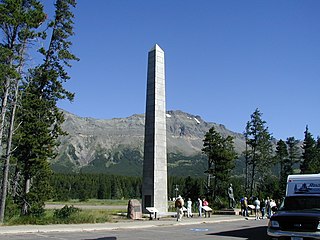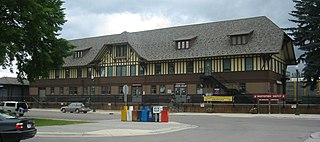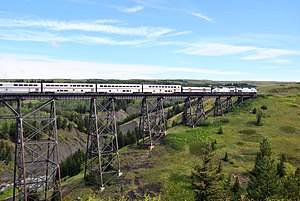
The Great Northern Railway was an American Class I railroad. Running from Saint Paul, Minnesota, to Seattle, Washington, it was the creation of 19th-century railroad entrepreneur James J. Hill and was developed from the Saint Paul & Pacific Railroad. The Great Northern's route was the northernmost transcontinental railroad route in the U.S.

BNSF Railway is the largest freight railroad in the United States. One of six North American Class I railroads, BNSF has 36,000 employees, 33,400 miles (53,800 km) of track in 28 states, and over 8,000 locomotives. It has three transcontinental routes that provide rail connections between the western and eastern United States. BNSF trains traveled over 169 million miles in 2010, more than any other North American railroad.

The Burlington Northern Railroad was a United States-based railroad company formed from a merger of four major U.S. railroads. Burlington Northern operated between 1970 and 1995.

The Empire Builder is a daily long-distance passenger train operated by Amtrak between Chicago and either Seattle or Portland via two sections west of Spokane. Introduced in 1929, it was the flagship passenger train of the Great Northern Railway and was retained by Amtrak when it took over intercity rail service in 1971.

The Flathead Tunnel is a 7-mile-long (11 km) railroad tunnel in the Rocky Mountains of northwest Montana near Trego, approximately 28 miles (45 km) west of Whitefish. Located on the BNSF Railway's Kootenai River Subdivision, it is the second-longest railroad tunnel in the United States after the Cascade Tunnel. It is ultimately named after the Bitterroot Salish, also known as the Flathead.

The North Coast Limited was a named passenger train operated by the Northern Pacific Railway between Chicago and Seattle via Bismarck, North Dakota. It started on April 29, 1900, and continued as a Burlington Northern Railroad train after the merger on March 2, 1970 with Great Northern Railway and the Chicago, Burlington and Quincy Railroad. The next year, it ceased operations after the trains which left their originating stations on April 30, 1971, the day before Amtrak began service, arrived at their destinations.

The North Coast Hiawatha was a streamlined long-distance passenger train operated by Amtrak between Chicago, Illinois, and Seattle, Washington.
The Hi-Line is a railroad in Montana running between Havre and Whitefish. It serves as a portion of the BNSF Railway Northern Transcon. Originally the mainline of the Great Northern Railway, the Hi-Line name has its origins in the railroad line being the northernmost transcontinental railway line in the United States. While the modern BNSF Railroad has only named this portion the Hi-line, the term is colloquially used for other portions of the Northern Transcon. Hi-Line also more generally refers to the area of northern Montana near the Canada–United States border and U.S. Highway 2.

Marias Pass is a mountain pass in the Rocky Mountains in the western US state of Montana. Lying on the southern border of Glacier National Park, it is traversed by US Highway 2 and by the BNSF Hi-Line Subdivision. The pass is the lowest crossing of the Continental Divide between Canada and central New Mexico , and is the northernmost pass in the US open to automobile traffic year-round.

Whitefish station is a stop on Amtrak's Empire Builder in Whitefish, Montana. In addition to the Empire Builder, a once-daily Greyhound Lines bus service also links the station to Kalispell and Missoula. A car rental agency operates a window within the station. The station and parking lot are owned by the Stumptown Historical Society. BNSF Railway leases office space on the upper floors of the station and owns the platform and track.

The Southern Transcon is a main line of BNSF Railway comprising 11 subdivisions between Southern California and Chicago, Illinois. Completed in its current alignment in 1908 by the Atchison, Topeka and Santa Fe Railway, when it opened the Belen Cutoff in New Mexico and bypassed the steep grades of Raton Pass, it now serves as a mostly double-tracked intermodal corridor.
The Columbia River Subdivision or Columbia River Sub is a railway line running about 167 miles (269 km) from Wenatchee to Spokane, Washington. It is operated by BNSF Railway as part of their Northern Transcon. The original line was built as part of James J. Hill's Great Northern Railway transcontinental railway line.
The Scenic Subdivision or Scenic Sub is a railroad line running about 155 miles (249 km) from Seattle, Washington to Wenatchee, Washington. It is operated by BNSF Railway as part of their Northern Transcon. This route includes the Cascade Tunnel, as well as the 1893 site of the "last spike" near Scenic, Washington, which marked the completion for the Great Northern Railway transcontinental railway line built by James J. Hill.
The Spokane Subdivision or Spokane Sub is a railway line running between Sandpoint, Idaho and Spokane, Washington. It forms a part of the Northern Transcon. The line has shared track rights with Union Pacific Railway. The Amtrak Empire Builder uses the line and stops in Sandpoint and Spokane.
The Lakeside Subdivision is a railway line in eastern Washington running about 149.4 miles (240.4 km) from Sunset Junction, west of Spokane to Pasco. It is operated by BNSF Railway and is considered part of the Northern Transcon.
The Cameron connector is a section of track built in 1995–1996 which connects the former Burlington Northern Railroad and the former Atchison, Topeka and Santa Fe Railway tracks, both which are now part of the BNSF Railway, to each other near Cameron, Illinois.
Haskell Pass, elevation 4300 feet, is a historically significant but now little-used mountain pass in northwestern Montana, between the Flathead and Kootenai River drainages. From 1892 to 1904 it was traversed by the original main line of the Great Northern Railway from Kalispell to Libby. This route was abandoned in favor of a longer but flatter route via the Stillwater, Tobacco, and Kootenai Rivers.
The Mission Mountain Railroad is a shortline railroad in northwestern Montana, operating a segment of the former Great Northern Railway since December 2004. MMT is a subsidiary of Watco, operator of several other shortline railroads.

The California Zephyr is a long-distance passenger train operated by Amtrak between Chicago and the San Francisco Bay Area, via Omaha, Denver, Salt Lake City, and Reno. At 2,438 miles (3,924 km), it is Amtrak's longest daily route, and second-longest overall after the Texas Eagle's triweekly continuation from San Antonio to Los Angeles, with travel time between the termini taking approximately 511⁄2 hours. Amtrak claims the route as one of its most scenic, with views of the upper Colorado River valley in the Rocky Mountains, and the Sierra Nevada. The modern train is the second iteration of a train named California Zephyr; the original train was privately operated and ran on a different route through Nevada and California.
The Fallbridge Subdivision is a railway line in southern Washington running about 229.7 miles (369.7 km) along the Columbia River from Pasco to Vancouver, then south to Portland, OR. It is operated by BNSF Railway and is considered part of the Northern Transcon.











